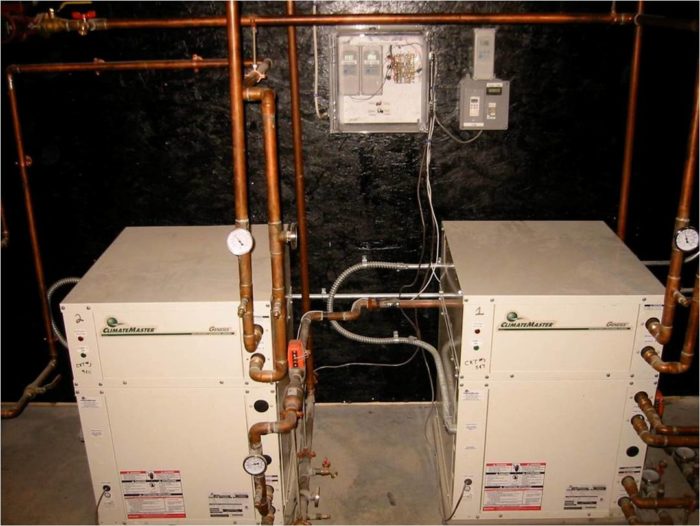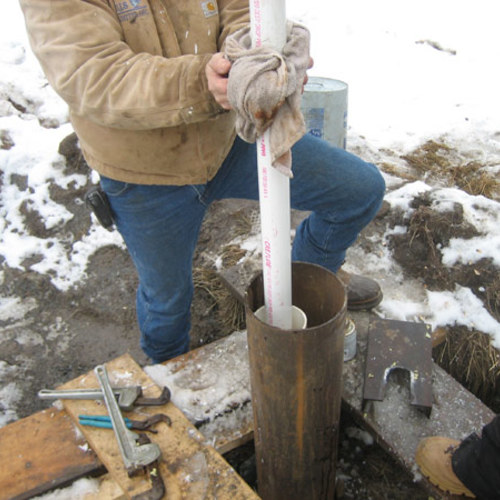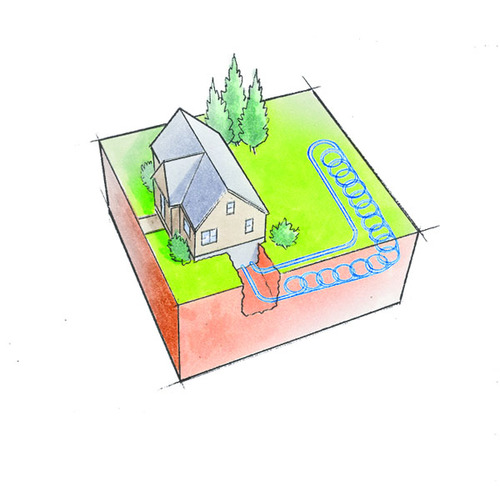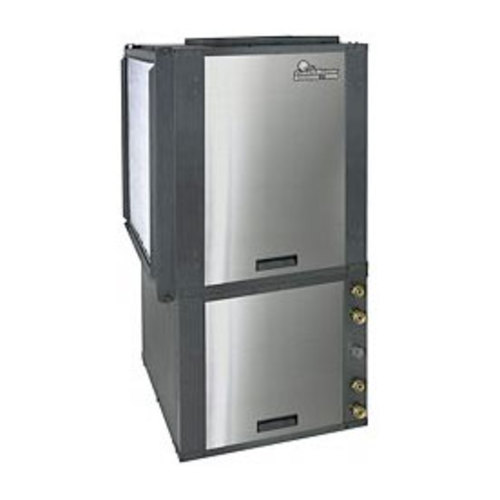
In Part One of this episode from the Green Architects’ Lounge, we only scratched the surface. Now it’s time to really dig in and decide if a ground-source heat pump system is right for you, and if so, to start planning for it.
In Part Two of the podcast, we discuss:
- A tale of two houses: Chris shares a story of two houses—one a success, and one that had to abandon using a ground-source heat pump
- Rule of thumb for flow: 3 gal. per minute per ton of heating/cooling
- Rules of thumb for well depth: Open Loop
55-ft. depth per ton at 30% bleed
85-ft. depth per ton at 10% bleed
150-ft. depth per ton at 5% bleed or less
- Rule of thumb for well depth: Closed Loop
175-ft. depth per ton
Be sure to check out Part One, where we discuss the difference between the various ground source heat pump options and share the recipe for a Dark and Stormy. Also, be sure to tune in later for Part Three, when we’ll play “Five Questions” with two professional ground source heat pump installers, Jeff Gagnon and Jim Godbout, and then address the elephant in the room: cost.
Enjoy the show.
RELATED MULTIMEDIA
Podcast: Ground Source Heat Pumps, Part 1: the BasicsPodcast: Ground-Source Heat Pumps, Part 3: Five QuestionsAre Affordable Ground-Source Heat Pumps On the Horizon?Ground-Source Heat Pumps (2010)Ground-Source Heat Pumps (2009)GBA Encyclopedia: Heat Pumps: The BasicsGBA Encyclopedia: Green Heating OptionsGround Source Heat Pumps Don’t Save EnergyGround Source Heat Pumps Have Low Operating CostsHeating a Tight, Well-Insulated HouseEquipment Versus EnvelopeIs a Ground-Source Heat Pump a Renewable Energy System?Air-Source or Ground-Source Heat Pump?
OFFICIAL TRANSCRIPT
Chris Briley: Want to talk about the advantages of open loop versus closed?
Phil Kaplan: Well, we talked about it briefly. There’s a higher risk when you do the open loop, and big cost ramifications.
Chris: Imagine this. This is the reason why if you go to Google “geothermal” or “ground source heat pumps” or talk to different people, you’re going to get zealots on each side saying, “I would never do ground source heat pumps; they make no sense whatsoever.” And then you turn right around and someone says, “They’re the best. I always do that because they’re so efficient and great.” I did a project—a 2500-sq.-ft. house with an energy-efficient shell and some passive solar design—and we did an open loop system. The whole infrastructure cost about $28,000, which is not bad for a ground source heat pump. I don’t think I could hit that number today; that was in 2006.
Phil: It’s not a cheap system.
Chris: It’s not. The owners of this house had one utility bill from June 2007 to June 2008—electric, because the pump runs on electricity—and it was just over $1,000. That’s pretty good. You spend $28,000 and your bill is $1,000 from now until whenever. You show that to somebody and they say, “Wow! I’m doing that!”
Now, I had another house of 2600 sq. ft. that we were going to do geothermal for. I got the quote for the well: $72,000. What? I asked if it was $72,000 for the pump and the well and the distribution, and he said no; the well and the earth coupling—getting water into the house—72 grand. I called up Jeff Gagnon—he and another mechanical contractor Jim Godbout will be on playing Five Questions. These guys are professionals who have installed this stuff with lots of success. So, Jeff gets on the phone, and he’s like “That’s insane!” Fast-forward a couple of weeks later, and the earth coupling is $32,000. So, I’ve got 30 grand inside the building and 30 grand outside. Uh-uh, we’re done. Good night, Irene. For a relatively efficient 2600-sq.-ft. house, there’s no way.
Why was that the case with one house and not the other? It comes down to a lot of the variables that have to do with an open-loop system. For instance, let’s talk about some rules of thumb for geothermal and an open loop system. For your ground source heat pump, you’re going to want to plan for about 3 gallons per minute of flow from your well—3 gallons a minute per ton to heat and cool. For a house with a 60,000 Btu demand, you’ll want about 5 tons of heat; a ton of heat is 12,000 Btu. I want 3 gallons a minute to go through that 5-ton system, so I need 15 gallons a minute to flow through that thing. That doesn’t necessarily mean the well has to produce 15 gallons a minute; I just have to have it available. So, there might be storage tanks or some other mechanism. The heat pump won’t always be on. You need flow out of the well. If you have a low-flow well, you have to dig deeper so that you have a higher recharge rate. With well depth in an open loop system, there’s a thing called bleed. I can draw water out, and I can put back up to 30% in a different location. If the house is near a body of water in Maine, the system has to have at least 5% bleed. What this means is I can pull the water out of the well, but I have to put it all back in except for 5% of it.
Phil: That still creeps me out a little, Chris.
Chris: It’s OK that it creeps you out, because there are some ramifications to this. Here’s a rule of thumb: If you’re doing an open loop system and you’re allowed to have 30% bleed, then it’s basically 55 ft. per ton of cooling. If the demand of the house is lower than the well is shallow…if you’ve got a high-demand house, then you need more water, you need more mass and you need more flow.
Phil: And it’s more expensive. So, smaller, more efficient house, and everything else gets cheaper.
Chris: If you can get down to 10% bleed, then you’re 85 ft. per ton. This is a standard 8- or 6-in. well casing. If you’re at zero bleed, then you’re at 150 ft. per ton. So, if you need 5 tons of heat, then you’re in a really deep well. And if you have an even higher-demand house with zero bleed, then you’re digging even deeper.
Now, back to that example of the house that didn’t work out—we were getting low yield off the well. We were probably getting 2 gallons a minute, and we had dug down 250 ft. That means we would have had to dig down quite a bit deeper, and in this region, we probably would have hit salt. If we hit salt water, everything has to be stainless steel, and it gets crazy. And we’re not allowed much bleed. So, we’d need one well to dump our bleed in, and we’d need two wells to feed the house. We’d be digging three wells for this house to make a geothermal system work. That’s insane.
All of this would be great to know up front, but since a lot of people are learning this as they slog their way through, they run into these variables.
Phil: I’m curious where in the country open loop is allowed and where it’s not allowed.
Chris: At the first house, that well almost went artesian. We were getting almost 100 gallons a minute and we were only 150 ft. deep. The well guy was like, “Guys, we are done here. If we go any further, we’re not going to be able to cap this thing. It will overflow, and we’ll have a stream in the back. Then we’ll have to plan for that.” I was thinking, “Awesome! We could put a turbine on it!” That was dumb, but I couldn’t help myself. Anyway, we did a classic pump and dump on that—which is frowned upon by people like you, and probably me, if I knew what was going on back then. Ninety percent of the water that comes out and goes through the pump gets discharged overboard. However, it’s only being used in the dead of winter. We were pulling out perfectly potable water at 150 ft. deep—not very deep in an aquifer—probably very similar water quality to what’s on top, and heck, they’re drinking it, so it’d better be good. We were just discharging that overboard, and it was a very wet environment where it was, so it was probably all OK. So, it was freezing cold outside, and freezing cold water was being dumped—who cares.
However, there are situations commercially … in fact, there’s a lawsuit at an inn that put in a significant geothermal system, an open loop system, and what happened was a lot of people around there started getting salt in their wells—which tends to happen coastally, but when it happens to an entire neighborhood after something just changed, which was the installation of this thing, they have a point. They have a class-action lawsuit, which is happening right now and may trigger some regulations in your state—which happened to us, which is why there are a lot of bleed regulations, especially around bodies of water.
Phil: So, if you want an open loop system, get it now while it’s still legal.
Chris: Well, what you want is to make sure it’s done responsibly. It may take two wells. Make sure you check all the regulations and your installer know what the heck he’s doing. Otherwise, you’re going to turn around and be spending 70 grand on a well they started a month ago that’s now three wells, because they’re learning on the job.
Phil: Closed loop—I love these rules of thumb.
Chris: In a closed loop system, you can do horizontal or you can do vertical. If you’re doing horizontal, that means coils of PEX tubing. You’ll dig down 6 to 8 ft. deep.
Phil: Oh, is it that much?
Chris: Well, if you’re in Virgina, 4 or 5 ft. deep. If you’re in Maine, 8 or 10 ft. deep—which is why we don’t do it here. There are only a few installations, and they’re not doing well. The closed loop horizontal is not so good when your frost depth is 48 in. That means the temperature is 32. Here in Maine we go vertical rather than horizontal.
Phil: So, unless you own a backhoe—which most of us do up here in Maine…
Chris: In a vertical closed loop system, instead of burying the tubes, you’re shoving them down a well—so the well has to be quite a bit bigger, because you’re not using the well water; you’re using water that you put into the well and draw back out again. That would typically be 175 ft. deep per ton. It’s not unheard of to be 1,000 ft. deep to do a closed loop vertical system.
Phil: I thought you were talking me into this.
Chris: No! Because a closed loop system—while more stable and more controlled and not dealing with bleed issues; you already know how deep you’re going to go and you’re not concerned about the flow of the well—that’s a lot of infrastructure.
Phil: Yeah, it is, but stay tuned. There’s a reason why these things are still around and people get excited about them. I’m a naysayer, but I’m wrong often. So, why don’t we take a little break, and when we come back we’re going to hear from two guys who are experts in this area. They’re going to tell us when a house is a good candidate for a ground source heat pump and when it’s not.
Weekly Newsletter
Get building science and energy efficiency advice, plus special offers, in your inbox.















11 Comments
thinking outside the box
Daikin Altherma.... sized to run only during the warmest 6 hours.... stores energy for the night in water... pulls from said water at night instead of cold night hours.
Result? Well with just a bit of extra green $$$$ the Altherma could run at a seasonal COP as good as good ground source and way better than bad ground source....
And... it wouldn't cost as much as a new Maseratti!!!!!!!!!!!!!
That is my killer system.
And... if yaa integrate with solar thermal... and solar electric... and passive house building techniques... it all becomes very small... to the point that I think one the the new heat pump water heaters could do the job instead of the possibly oversized Altherma.
the dog
Daikin Altherma
Daikin Altherma systems cost between $10,000 and $20,000 -- still a lot more than a ductless minisplit system.
I got a quote on an Altherma
I got a quote on an Altherma for $36K installed in an 1800sqft house. It was $4k more than a gshp after you take CT state rebates into account. IMO they are both too expensive. If you have a superinsulated house its tough to argue against the mini splits at $1500 a pop.
Response to Nick
Nick,
Thanks for the information. $36,000 is steep.
It makes me realize how lucky I am that my $100 heating system (a used wood stove) is still working fine after several decades.
Great info to do with price.
I am an installer so my price would be a third of what you are quoting most likely.
But... also that is why I think a modified water heater heat pump might just do the trick for a small passive house. I need a source of a small heat pump that will heat water during the high daytime temperatures for my idea to fly.
The dog
wells
well my wells were "only" about $7K including variable speed pump, inverter, bringing into basement, well tank. The source well was about 56 ft deep and the rejection well about 40 ft deep. The source well will produce at least 25gpm, (I only need about 7 gpm most of the time - two stage pump), that is with a 4" casing.
On the south side of Long Island water is typically found at shallow depths, water was at about 30ft in my case.
The ground type is sandy.
Just 20 miles away on the north shore of Long Island where it is very rocky you might have to drill 250 ft or more through rock to get only a fraction of what my well produces.
So I really don't understand how you can have a rule of thumb for well depth, when I wells vary so much by geology.
Also I didn't understand the issue of bleed in the article. PLEASE EXPLAIN MORE.
I have a rejection/return well about 75 ft from the source well where 100% of the water is returned to.
Also I return the water into the water table via a 1" pipe rather than letting it drop down the well casing potentially causing any iron in the water to deposit as oxide on the well casing.
Well depth per ton
Christopher, one of your rules of thumb given for open loop is:
"55-ft. depth per ton at 30% bleed
85-ft. depth per ton at 10% bleed
150-ft. depth per ton at 5% bleed or less"
What is the source of your information? There is a reference in the website for Water Energy Distributors to an article that tabulates a lot of measured data for standing column well designs (SCW) in the northeast. In general, the water column depth per ton of load seems to be around half of your 150 ft for 5% bleed or less.
Rules of thumb
For starters I should really state that the rules of thumb are just rules to help one conceptualize what one is LIKELY to need for a standing column well depth. So in the case of the high-yield, shallow well system in Long Island that Mark, you mention, I should think this is a very atypical installation (perhaps not for Long Island, but certainly for New England). My rules come right from Jeff Gagnon who I've left a message with informing him that these questions are coming up. My hope is he'll chime in on occasion, though I happen to know he's quite busy these days. My rules are possibly regional to New England, and perhaps I was not clear enough about that, though I should think it would be very similar for other moderate to cold climates in the country. But like I tried to state in my examples, the well is the giant wild card for an open loop system. Things could go your way and you'll get plenty of flow from a shallower well or you may have to drill through hundreds of feet of bedrock to get a very low flow. (I'm reminded of the movie "Mr. Blandings Builds His Dream House" where his 6' deep foundation is flooded and they cant get the water out while the well driller is up to 200' deep and still hasn't hit water yet)
More on Bleed and well depth
With a GSHP system, two things work for you: the ability of the well to recharge (or flow), and the thermal mass (depth or volume) of the water in the well. If one of these is low then the other needs to be high to compensate.
In an open loop, standing column system, GSHPs take water out of the well and (assuming we’re heating the house for the sake of this demonstration) take the heat out of the water and dump back in freezing cold water into the well. So in this case you are starting to cool down your well water which also means the water you draw out gets colder and colder making the system less and less efficient. Therefore the more massive (or deep) the well is, the harder it will be for you change its temperature.
Now, what if, instead of dumping that water back into the well, you dumped it “overboard” into a drywell? You could eliminate this well-cooling phenomena and keep your well at it’s optimum efficiency. This is called bleed. The more bleed you have, the greater the volume, OR recharge rate, your well needs to have. This is why, if you have lots of bleed your well doesn’t need to be as deep (though it does need to have good flow). In some parts of the country, especially near bodies of water or high population areas, the amount of bleed you are allowed is limited.
I hope that clears things up a little.
Chris
Very interesting podcast series
On geothermal systems and ground source heat pump equipment. It really does put a lot into perspective for me. I wish I had more time to comment now. But I did read Chris's transcript of the dinner discussion with the American passive house people, which got me thinking alot. I scribbled down some hand notes and hopefully by the holidays in December, I will get some time to respond properly. Looking forward to the next stage of this podcast, where the expert M&E contractors are brought in.
1 GPM per ton open loop
I have a 3-ton water-air heat pump. These cost $4-$5000 at HVAC distributors.
I have a ~25' dug well, which I use for domestic water & the heat pump; i.e. no incremental cost for the heat pump.
With a 3.0 COP, the heat pump needs to get 24,000BTU/hr of heat from the water. If you have 50F water coming in and 32F going out, that's 27,000BTU/hr of heat extracted at 3GPM. And freezing is not an issue, since you need to take 80BTU of heat out of 1lb of water at 32F to freeze it. I've run my heat pump at under 1GPM per ton with water coming in from the well at ~45F. The water coming out of the heat pump has some visible ice crystals but it does not freeze up until I drop the flow rate to ~0.7GPM/ton (something I don't recommend you try since it could damage your heat exchanger).
Log in or create an account to post a comment.
Sign up Log in